My imported data set consists of predetermined ranges and their probability density values. I have plotted this in a bar chart in R. So my plot shows a histogram, but to R its just a bar plot. However, I now need to put a curve on this bar chart for visualization purposes, using same data in bar chart.
The code I have used so far is creating a funny looking curve that doesn't fit appropriately to the bar chart...Any help would be hugely appreciated please!
Code used so far:
barplot(Data10$pdf, names = Data10$ï..Weight.Range, xlab = "Weight", ylab = "Probability Density", ylim = c(0.00,0.05), main = "Histogram")
fit1<-smooth.spline(Data10$ï..Weight.Range, Data10$pdf, df=12, spar = 0.2)
lines(fit1,col="blue", lwd=3)
Link to output of this code:
Data:
Data10 <- structure(list(
ï..Weight.Range = c(0, 0.5, 1, 1.5, 2, 2.5, 3,
3.5, 4, 4.5, 5, 5.5, 6, 6.5, 7, 7.5, 8, 8.5, 9, 9.5, 10, 10.5,
11, 11.5, 12, 12.5, 13, 13.5, 14, 14.5, 15, 15.5, 16, 16.5, 17,
17.5, 18, 18.5, 19, 19.5, 20, 20.5, 21, 21.5, 22, 22.5, 23, 23.5,
24, 24.5, 25, 25.5, 26, 26.5, 27, 27.5, 28, 28.5, 29, 29.5, 30,
30.5, 31, 31.5, 32, 32.5, 33, 33.5, 34, 34.5, 35, 35.5, 36, 36.5,
37, 37.5, 38, 38.5, 39, 39.5, 40, 40.5, 41, 41.5, 42, 42.5, 43,
43.5, 44, 44.5, 45, 45.5, 46, 46.5, 47, 47.5, 48), pdf = c(0.012697609,
0.015237131, 0.017776653, 0.019046414, 0.020694512, 0.022575831,
0.024457151, 0.02633847, 0.028219789, 0.030101109, 0.031982428,
0.033863747, 0.035745066, 0.037626386, 0.039507705, 0.041389024,
0.043270343, 0.045151663, 0.042420729, 0.03688759, 0.033198831,
0.029510072, 0.026374627, 0.023976934, 0.02264407, 0.021614794,
0.020585518, 0.019556242, 0.018526967, 0.017497691, 0.016468415,
0.015439139, 0.014409863, 0.013380587, 0.012351311, 0.011322035,
0.009839476, 0.008433837, 0.007731017, 0.007028197, 0.005622558,
0.004919738, 0.004568328, 0.004498046, 0.004427764, 0.004357482,
0.0042872, 0.004216918, 0.004146636, 0.004076354, 0.004006072,
0.00393579, 0.003865508, 0.003795226, 0.003724944, 0.003654663,
0.003584381, 0.003514099, 0.003443817, 0.003373535, 0.003303253,
0.003232971, 0.003162689, 0.003092407, 0.003022125, 0.002951843,
0.002881561, 0.002811279, 0.002740997, 0.002670715, 0.002600433,
0.002530151, 0.002459869, 0.002389587, 0.002319305, 0.002249023,
0.002178741, 0.002108459, 0.002038177, 0.001967895, 0.001897613,
0.001827331, 0.001757049, 0.001686767, 0.001616485, 0.001546203,
0.001475921, 0.001405639, 0.001335357, 0.001265075, 0.001194794,
0.001124512, 0.00105423, 0.000983948, 0.000913666, 0.000843384,
0.000773102)
), class = "data.frame", row.names = c(NA, -97L))

